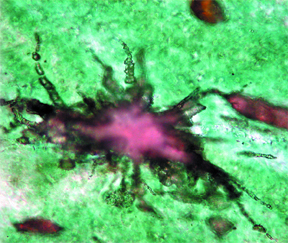 Microbes thrive
in unexpected places, including seafloor hotspots, where energy and nutrients
from hydrothermal vents or volcanic activity make life easy. Such environments
may also have provided fertile grounds for the start of early life, but finding
the evidence has proven tricky. A team of geoscientists claim to have found
just that in 3.5-billion-year-old rocks from the Barberton greenstone belt in
South Africa.
Microbes thrive
in unexpected places, including seafloor hotspots, where energy and nutrients
from hydrothermal vents or volcanic activity make life easy. Such environments
may also have provided fertile grounds for the start of early life, but finding
the evidence has proven tricky. A team of geoscientists claim to have found
just that in 3.5-billion-year-old rocks from the Barberton greenstone belt in
South Africa.This photomicrograph shows that some ancient volcanic rocks from South Africa contain tiny segmented straw-like forms, which may have been made by microbes 3.5 billion years ago. Courtesy of Science and Furnes et al.
Over the past decade, researchers have examined microtubules in modern volcanic glass from the seafloor. By showing DNA associated with the tiny channels and using other analytical techniques, scientists linked the tiny tubes to modern microbial activity. A team led by Harald Furnes, a geochemist and petrologist at the University of Bergen, Norway, went in search of older rocks that might hold similar structures, searching and finding seemingly fossilized microtubules in ophiolites in Cyprus, Finland and elsewhere.
But Furnes and his co-authors found their most ancient example of the microtubules, which are several microns wide and tens of microns long, in South Africa. The region has some of the oldest and best-dated ancient pillow basalts, which have sat relatively unchanged for billions of years.
In the April 23 Science, the team lays out several lines of supporting evidence showing a microbial origin for the tiny tubes. One key finding is low carbon-isotope ratios in the outer glassy rims of the pillow basalts: The presence of more carbon-12 than carbon-13 in carbonates tends to be a signature of life because some microbes seem to prefer lighter carbon, which presumably takes less energy to metabolize. The researchers also found titanite, a mineral that filled the microtubules, in forms unlike crystals that would be made in normal geologic processes, without any help from life forms.
Neil Banerjee, a geochemist at the University of Alberta and second author on the paper, says the team is confident in their conclusions that the microtubules were made by microbes because of their supporting evidence from carbon isotopes and other X-ray measurements. But, he says, “in the end, the textures are the smoking gun — they are the right size, right shape and right distribution.”
However, says Jan Amend, a geochemist at Washington University in St. Louis, Mo., the main argument of morphology is not “robust enough.” Citing earlier findings where morphology has misled (such as with the Allan Hills meteorite that seemed to hold evidence of microbial life on Mars), Amend says, “we’ve been fooled too many times by similar morphology,” either by what looks like microbes or “what may have been left behind.”
Altogether, Amend says, the supporting evidence is “suggestive” if not definitive. In particular, he notes that the amount of carbonates available for testing in the ancient ophiolite samples was small and the subsequent data points showing the light carbon isotope ratios few. “I don’t think the data have proven them wrong, but they haven’t proven them right yet,” Amend says. “Now other scientists can hack away at it.”

